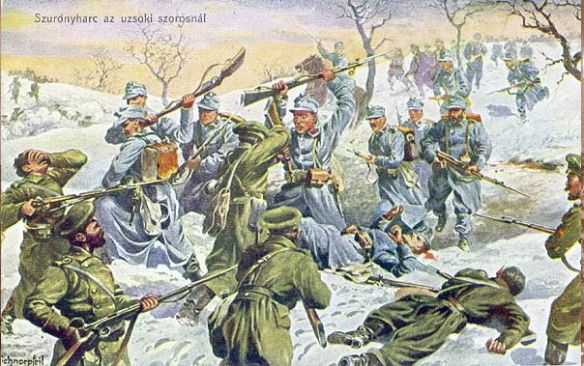In Vienna, there was a large gap between ideals and reality when it came to war. The poorly equipped Austro-Hungarian army was recruited from a great variety of ethnic groups, often with doubtful loyalty to the emperor. Mobilisation posters in 1914 came in 15 languages for an army that was 44% Slav, 28% German, 18% Hungarian, 8% Rumanian and 2% Italian, which created command problems between the German-dominated officer corps and the men. But the main difficulty in 1914 was the over-ambitious plans of the Austro-Hungarian commander, Conrad von Hötzendorf, whose lament that he deserved a better army was echoed by his men’s complaint that they deserved a better commander. Life in the Austro-Hungarian army is well described in Jaroslav Hasek’s book The Good Soldier Svejk.
In 1914, Conrad divided his army into three: A Staffel (A Echelon), 38 divisions in Galicia facing the Russians; 8 divisions in the Minimalgruppe Balkan (Balkan Task Force) by Serbia; and B Staffel – the Second Army of 13 divisions – in reserve. If Conrad wanted to get B Staffel to Galicia on Austria-Hungary’s slow troop trains, he would need to do so no later than five days after mobilisation began (the fifth day being 1 August). Believing that Serbia could be defeated before Russia mobilised, Conrad committed B Staffel to the Serbian front before a more rapid than expected Russian mobilisation forced him to re-deploy it to Galicia. Thus, B Staffel left the Serbian front before it could win a victory but got to Galicia in time to participate in a defeat.
The main Austro-Hungarian fortresses at Lemberg (L’vov or Lwow), Krakow and Przemysl protected Galicia. Thereafter the main line of resistance for the 480-kilometre (300-mile) front lay along the Carpathian passes. Russian plans called for the deployment in Galicia of four armies and, by the end of August 1914, the Russians had deployed 71 divisions. Conrad deployed three armies of 47 divisions (plus B Staffel that arrived by 8 September) that advanced on 23 August with catastrophic results. Deployed on a front of 280 kilometres (175 miles) and dangerously split, Conrad’s men fanned out, heading north into Poland and east into the Ukraine, increasing attack frontage and diluting their strength. The result was battles in late August and early September 1914 at Gnila Lipa, Komarow and Zlota Lipa. Believing that he was winning, in the face of overwhelming contrary evidence, Conrad tried to outflank and encircle the Russians. He was, however, trying to outflank a stronger force with a weaker force and, looking at total defeat, he ordered a general retreat of some 240 kilometres (150 miles) to the Carpathians, leaving behind 150,000 men besieged in Przemysl (which fell in March 1915). In three weeks, Austria-Hungary had lost 400,000 men, including 300,000 prisoners-of-war. The army also lost experienced officers and men; their replacements, riddled with nationalism, were less reliable and liable to desert. The Russians lost 250,000 men and 100 guns and made little effort to pursue their disorganised opponent. After the Lemberg disaster, there was a series of confused indecisive battles (October-December 1914) as the Russians attacked in an extended line from Poland to Galicia. By Christmas, Austria-Hungary had established a defensive line from the Vistula to Tarnow and the line of the Carpathians. Total Austro-Hungarian casualties for 1914 numbered 750,000.
